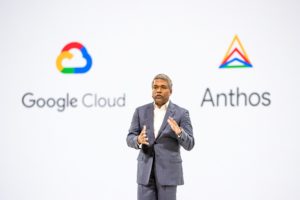Great expectations can be a crushing burden for some businesses and some leaders. But Google Cloud and CEO Thomas Kurian are about to wrap up up not just a hugely successful global customer conference with Next ’19, but also what has to be seen as a massive relaunch of a brand eager to move from under-performer to world-class competitor.
Within that context, here’s my sense of where Kurian and the Google Cloud team will focus in the near future. This list of themes from Next ’19 pull from Kurian’s public comments as well as earlier briefings.
1. Customer Focus Is Renewed, Intensified, Expanded.
Kurian spoke at length on a few different occasions about “customer empathy” and the need for Google Cloud to “meet customers where they are, not where we happen to think they should be.” Kurian spoke specifically about the need for his company to understand that while some legacy systems might be outdated, the companies running them are doing so for very particular and legitimate reasons. So rather than look down their nose at such situations, Google Cloud people have to openly and sincerely strive to understand those reasons, understand that customer’s unique challenges and needs, understand that customer’s goals and objectives, and then co-create with that customer the best solution for that customer’s particular needs. This is a big shift from the early days when some Google Cloud folks felt their job was simply to tell customers, “You should run your business the way we run ours.”

2. Anthos: A Breakthrough Driver of Business Value.
The new hybrid platform, whose impact we discussed yesterday in Google ‘Anthos’ and New CEO Turn Up the Heat On Microsoft and Amazon, will be the centerpiece for Kurian’s plan to model Google Cloud’s vast array of powerful
technologies around customers’ needs. In particular, Anthos will become the foundation for the company’s new approach of helping customers drive digital transformation initiatives. This approach also includes infrastructure, industry-specific solutions and a greatly expanded partner program.
3. Infrastructure.
Putting Google’s vast IaaS prowess in the context of helping businesses move to the cloud and undergo digital transformation—an objective Kurian came back to over and over—Kurian outlined plans to:
- help customers migrate and modernize existing workloads into the cloud with Velostrata;
- target the huge number of SAP mission-critical workloads moving to the cloud with the industry’s highest-availability and most-powerful virtual machines;
- offer an end-to-end security strategy pledging to protect infrastructure, data, and users with complete transparency;
- meet or exceed AWS and Microsoft in the number of availability zones and regions offered around the globe; and
- create and clearly convey a sweeping and uncompromising privacy policy.
4. Greatly Expanded Sales and Go-To-Market Capabilities.
Acknowledging Google Cloud’s inadequate commitment to these areas in the past, Kurian offered this outline:
- a pledge to “very rapidly scale our sales and distribution resources”;
- dramatically boost the resources devoted to partner programs;
- create a “customers for life” program, spanning early engagements to increasingly broad relationships to turning customers into evangelists;
- “make it incredibly easy for customers to do business with us”—simplified contracts, smoother engagement models with partners, simplified methods for governing IP issues and ownership; and
- a “business-value selling methodology” built around solutions centered on the business-transformation needs of customers.
5. Industry-Specific Solutions.
Kurian described Google Cloud’s new services for automating call centers with fully functional digital agents—“these are far beyond chatbots,” he said—as well as working closely with partners and customers in the six industries, including media and entertainment, healthcare, retail, financial services, public sector.
6. AI and ML.
These technologies were mentioned in almost every aspect of Kurian’s presentations and comments. The focus on artificial intelligence and machine learning represent another way in which parent-company Google is intent on helping Kurian bring the best of the company’s IP to Google Cloud customers. In particular, Kurian mentioned the example of media companies with massive catalogs of video assets that can’t currently be searched. With Google’s AI and ML capabilities, those can be turned into high-potential digital assets with huge business potential.

7. Partners.
From Accenture and Deloitte co-creating new industry-specific solutions to bringing more ISVs into the Google Cloud ecosystem, Kurian spoke passionately about the force-multiplier effect partners will have in the company’s new approach to the market.
8. Developers.
The centerpiece of this new effort involves a unique approach to working with open-source providers. Google Cloud looks to provide access to large enterprises, and give those customers a simpler and less-risky way of handling the commercial aspects. For an interesting take on this, check out CNBC’s article, Google is challenging Amazon in the cloud by partnering with open-source companies instead of competing with them.
9. Cybersecurity.
As with AI and ML, Kurian is tapping into the company-wide cybersecurity assets to deliver on the sweeping promise noted above: protecting customers’ infrastructure, protecting their data and protecting their users.
10. G Suite Positioned as Changing How Companies Work.
It will be very interesting to see how Kurian pursues the SaaS market in a highly differentiated approach from big SaaS players like Salesforce, SAP, Oracle and Workday. He is starting with a combination of productivity tools in G Suite to the high-end industry-specific solutions described above. Kurian said that some very large companies have used G Suite as major elements in their digital transformations—and he made it clear that these widely used apps will play a major role going forward.
In conclusion: as I’ve noted before, the re-entry of a customer-centric and aggressive Google Cloud into the Cloud Wars will force all competitors to get much better very quickly, and will provide customers with more choices, more capabilities, and more value.
(Disclosure: Google Cloud paid for my hotel room during its Next event.)
Subscribe to the Cloud Wars Newsletter for in-depth analysis of the major cloud vendors from the perspective of business customers. It’s free, it’s exclusive, and it’s great!








